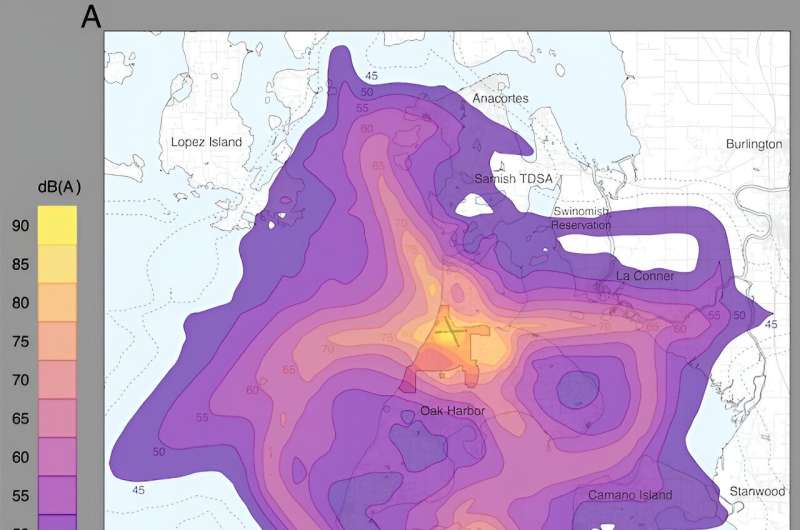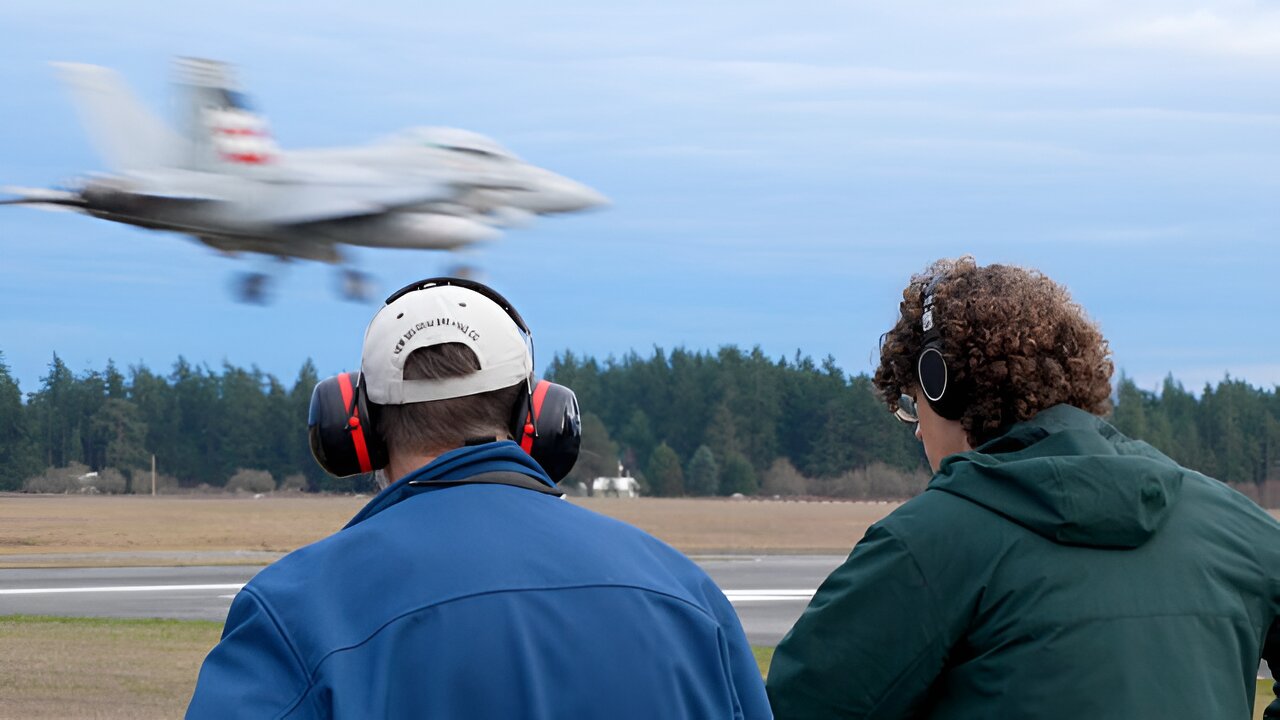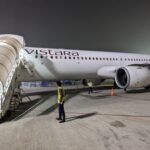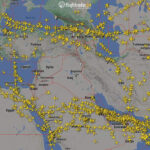Bob Wilbur and Giordano Jacuzzi, co-authors of the study, see a Growler jet land on Whidbey Island. Credit: Kiyomi Taguchi/UW News
Bob Wilbur thought he had found a retirement home that would be a place of peace. Nestled against Admiralty Bay on the western edge of Whidbey Island, the three-story home is surrounded by trees and shoreline. It offers the kind of tranquility that only an island can provide. Except when the Growlers fly.
As often as four days a week, Boeing EA-18G Growler electronic attack aircraft, based at nearby Naval Air Station Whidbey Island, fly overhead as pilots practice touch-and-go landings. The sound is immense, about the level of a loud rock concert.
“It interrupts your day,” Wilbur said. “You can’t have a pleasant evening at home. You can’t communicate. You try to organize the whole day so that you are away when the jets fly.”
New research from the University of Washington shows that the noise is not only disruptive, but also poses a significant risk to public health. Published in the Journal of Exposure Science and Environmental EpidemiologyAn analysis of the Navy’s own acoustic monitoring data found that more than 74,000 people are exposed to noise levels associated with adverse health effects.
“The noise from military aircraft is significantly more intense and disturbing than the noise from commercial aircraft,” said lead author Giordano Jacuzzi, a graduate student at the UW College of the Environment. “Noise exposure has many consequences beyond just annoyance and stress – many sleep disorders, hearing loss, increased risk of cardiovascular disease – these have real consequences for human health and quality of life. We also found that several schools in the area were exposed to levels that have been shown to put children at risk of learning loss.”
Guided by conversations with community members and local advocacy groups, researchers analyzed four weeks of acoustic and flight operations data collected by the Navy in 2020 and 2021, in addition to data collected last year by a private acoustic company and the National Park Service. . Researchers then mapped noise exposure across the region to estimate how much noise specific communities were exposed to in an average year.
Researchers estimate that two-thirds of Island County residents, including everyone in the towns of Oak Harbor and Coupeville, were exposed to potentially harmful noise levels, as were 85% of the population of the Swinomish Indian Reservation.
In total, an estimated 74,316 people were exposed to average noise levels that posed a risk of annoyance, of whom 41,089 people were exposed to nighttime noise levels associated with adverse effects on sleep. A further 8,059 people – most of whom lived reasonably close to aircraft runways – were exposed to noise levels that could pose a long-term risk of hearing damage.
“Our bodies generally produce a lot of stress hormone responses to noise, it doesn’t matter what type of noise it is. But especially if it’s this repetitive acute noise, you would expect the stress hormone response to worsen,” says Co. -author Edmund Seto, professor of environmental and occupational health sciences at the UW.
“What was really interesting was that we are reaching levels of noise exposure that are actually harmful to hearing. Normally I only think about hearing when I work in factories or other very loud occupational environments. But here we are reaching those levels for the community.”

This map shows the simulated noise exposure associated with adverse health effects. The contours are shown in steps of 5 decibels, starting at an average day-night noise level of 45 decibels. Credit: Journal of Exposure Science & Environmental Epidemiology (2024). DOI: 10.1038/s41370-024-00670-1
Overall, the potential damage could be quite serious, Seto said. “Imagine people trying to sleep, or kids at school trying to understand their teachers, and then you have airplanes flying.”
Every monitoring station on Whidbey Island has measured noise events exceeding 100 decibels during flight. In some cases, noise levels were ‘off the charts’ and exceeded the limits of models used to predict the health effects of noise exposure around the world.
“We found it striking that Growler noise exceeds the scientific community’s current understanding of its potential health outcomes,” said co-author Julian Olden, professor of aquatic and fisheries sciences at the UW. “For this reason, our estimates of health impacts are conservative.”
The noise has been the subject of community disputes and legal controversy since 2013, when the U.S. Navy moved more Growler jets to Whidbey Island and increased the number of flights to more than 110,000 per year. Bob Wilbur is a member and current president of Citizens of Ebey’s Reserve, a community group that has sued the Navy over aircraft noise and increased flight operations. The group also helped facilitate the UW study, and Wilbur is a co-author.
Like other military aircraft, the sound of the Growlers differs significantly from that of commercial aircraft: louder and deeper, the kind of sound people feel before they hear it.
“It’s about the intensity, the intermittent nature of the sound and especially the low-frequency energy,” Jacuzzi said. “Those three things are very different from what you experience on normal commercial flights, which are predictable and at high altitudes. When Growlers fly over a house, they emit a rumbling sound that penetrates windows and shakes walls.”
Although commercial aircraft noise has been the subject of extensive research, research on military aircraft noise is relatively rare. Previous research led by the UW found that military flights were the most important largest cause of noise pollution on the Olympic Peninsula. While discussing that research, Whidbey residents complained that the noise was disrupting their sleep and disrupting students’ schoolwork, prompting this new line of research. While conducting this study, researchers worked closely with community members and advocacy groups and held multiple webinars to share results and shape future work.
“Our investigation was motivated by the growing chorus of complaints from Washingtonians in multiple counties,” Olden said. “We believe the science speaks for itself. It is no longer a question of whether noise affects people, but how, where and how much these effects are experienced.”
Other authors include Lauren Kuehne of Omfishient Consulting, and Anne Harvey and Christine Hurley of Sound Defense Alliance.
More information:
Giordano Jacuzzi et al., Public Health Implications of Exposure to Widespread Noise Pollution from Military Aircraft, Journal of Exposure Science & Environmental Epidemiology (2024). DOI: 10.1038/s41370-024-00670-1
Quote: Navy Growler jet noise over Washington state’s Whidbey Island could affect health of 74,000 people (2024, May 9), retrieved May 9, 2024 from https://medicalxpress.com/news/2024-05-navy -growler-jet-noise-washington. html
This document is copyrighted. Except for fair dealing purposes for the purpose of private study or research, no part may be reproduced without written permission. The content is provided for informational purposes only.



















